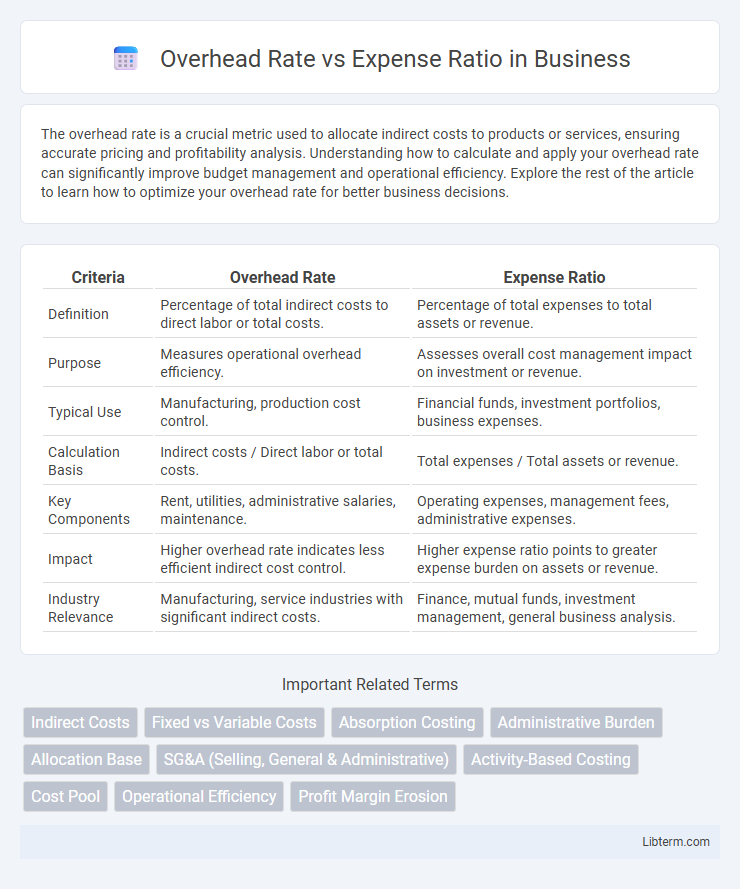The overhead rate is a crucial metric used to allocate indirect costs to products or services, ensuring accurate pricing and profitability analysis. Understanding how to calculate and apply your overhead rate can significantly improve budget management and operational efficiency. Explore the rest of the article to learn how to optimize your overhead rate for better business decisions.
Table of Comparison
| Criteria | Overhead Rate | Expense Ratio |
|---|---|---|
| Definition | Percentage of total indirect costs to direct labor or total costs. | Percentage of total expenses to total assets or revenue. |
| Purpose | Measures operational overhead efficiency. | Assesses overall cost management impact on investment or revenue. |
| Typical Use | Manufacturing, production cost control. | Financial funds, investment portfolios, business expenses. |
| Calculation Basis | Indirect costs / Direct labor or total costs. | Total expenses / Total assets or revenue. |
| Key Components | Rent, utilities, administrative salaries, maintenance. | Operating expenses, management fees, administrative expenses. |
| Impact | Higher overhead rate indicates less efficient indirect cost control. | Higher expense ratio points to greater expense burden on assets or revenue. |
| Industry Relevance | Manufacturing, service industries with significant indirect costs. | Finance, mutual funds, investment management, general business analysis. |
Understanding Overhead Rate and Expense Ratio
Overhead Rate measures the proportion of indirect costs such as rent, utilities, and administrative expenses relative to total direct labor or production costs, helping businesses allocate fixed expenses accurately. Expense Ratio quantifies the percentage of total expenses compared to total revenues, often used in investment funds to assess cost efficiency. Understanding the distinction between Overhead Rate and Expense Ratio enables organizations to better manage operational expenses and improve overall financial performance.
Definition of Overhead Rate
The overhead rate is a financial metric that represents the proportion of indirect costs or overhead expenses to a specific cost base, such as direct labor hours or total production costs. It measures how much overhead is allocated per unit of production or service, helping organizations determine accurate product or project costing. Unlike the expense ratio, which evaluates the efficiency of managing total expenses relative to revenue, the overhead rate specifically focuses on the distribution of fixed and variable overhead costs.
Definition of Expense Ratio
The expense ratio measures the percentage of a fund's assets used for operating expenses, directly affecting investor returns by reducing net income. Unlike the overhead rate, which includes broader indirect costs, the expense ratio specifically highlights ongoing management fees and administrative expenses within investment funds. This metric is essential for investors to evaluate cost efficiency and compare fund performance accurately.
Key Differences Between Overhead Rate and Expense Ratio
The overhead rate measures the indirect costs allocated to production relative to direct labor or materials, highlighting efficiency in managing operational expenses. The expense ratio compares total operating expenses to total revenue, reflecting overall cost management and profitability. Key differences include that the overhead rate focuses on specific indirect costs in production, while the expense ratio encompasses all operating expenses, offering broader insight into financial health.
Importance of Tracking Overhead Rate
Tracking the overhead rate is crucial for accurately assessing the true cost of operations and maintaining profitability. It provides businesses with insight into fixed and variable expenses beyond direct costs, enabling better budgeting and financial planning. Monitoring the overhead rate ensures efficient resource allocation and supports pricing strategies that reflect the complete cost structure.
Importance of Monitoring Expense Ratio
Monitoring the expense ratio is crucial for investors because it directly impacts net returns by reflecting the percentage of fund assets used for management fees and operating costs. Unlike the overhead rate, which mainly pertains to internal business expenses, the expense ratio offers a clear measure of fund efficiency and cost-effectiveness. Keeping a close watch on the expense ratio helps ensure that investment portfolios remain cost-efficient, maximizing long-term growth potential.
Calculation Methods for Overhead Rate
The overhead rate is calculated by dividing total overhead costs by a specific allocation base, such as direct labor hours or machine hours, to determine the cost applied per unit of activity. This method ensures that overhead expenses are proportionally assigned to products or services based on their usage of resources. Unlike the expense ratio, which represents the percentage of total revenue spent on operating expenses, the overhead rate specifically quantifies indirect costs linked to production or service delivery.
Calculation Methods for Expense Ratio
Expense Ratio is calculated by dividing the total operating expenses of a fund by its average net assets, typically expressed as a percentage. This metric includes management fees, administrative costs, and other expenses, offering investors insight into the cost of managing a mutual fund or ETF. The Overhead Rate, however, refers primarily to fixed business costs and is not usually detailed in the same proportional terms as the Expense Ratio, which provides a more comprehensive view of ongoing fund expenses.
Industry Benchmarks: Overhead Rate vs Expense Ratio
Industry benchmarks for Overhead Rate typically range between 20% and 35%, depending on the sector, while Expense Ratios in investment funds commonly fall between 0.5% and 2.0%. Manufacturing and service industries often exhibit higher overhead rates due to labor and administrative costs, whereas fund managers strive to maintain low expense ratios to maximize investor returns. Comparing these metrics across similar companies or funds provides valuable insights into operational efficiency and cost management effectiveness.
Optimizing Expenses: Reducing Overhead Rate and Expense Ratio
Reducing the overhead rate and expense ratio is critical for optimizing expenses and improving financial efficiency within a business. Strategies such as automating administrative tasks, negotiating better supplier contracts, and cutting non-essential spending directly lower overhead costs and overall expense ratios. Monitoring these metrics regularly enables businesses to identify cost-saving opportunities and enhance profitability.
Overhead Rate Infographic

 libterm.com
libterm.com